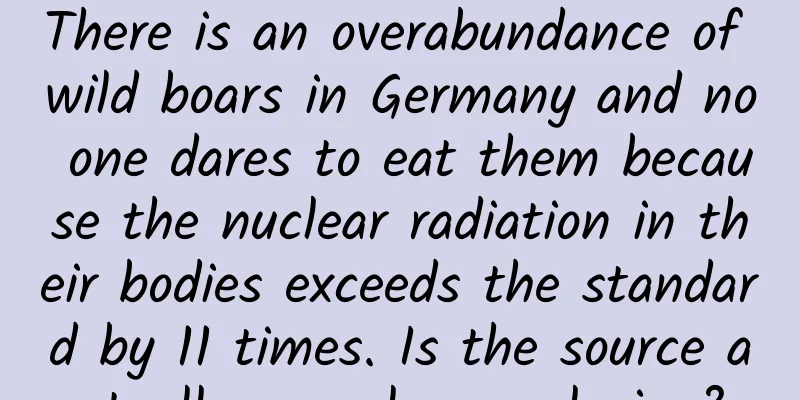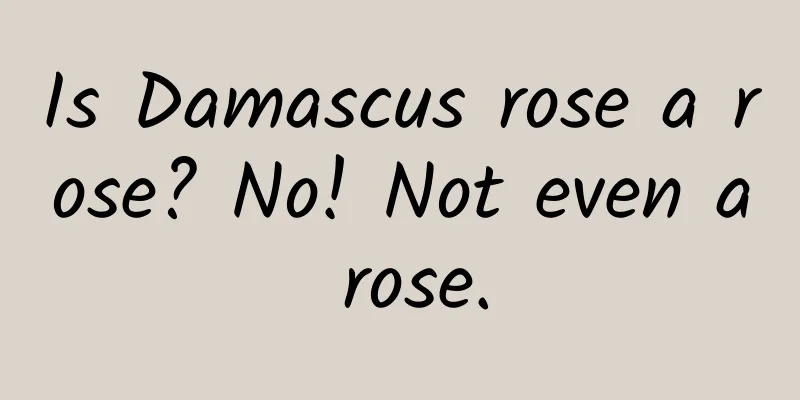There is an overabundance of wild boars in Germany and no one dares to eat them because the nuclear radiation in their bodies exceeds the standard by 11 times. Is the source actually a nuclear explosion?

|
In Bavaria, Germany, during the hunting season, hunters go to the forest to hunt wild boars, but the dead wild boars generally cannot be eaten or sold because the wild boars there mostly have excessive nuclear radiation levels . In 2009, hunters in Bavaria received nearly 425,000 euros in compensation for wild boar meat that could not be sold due to radiation contamination, according to Berlin's environment ministry. Wild boars killed in other parts of Germany can still be eaten because their meat does not contain high concentrations of radioactive cesium. According to local regulations, if the cesium concentration in the meat of a killed wild boar exceeds 600 becquerels per kilogram, it can only be burned or buried. In the Bayern Forest, a forest area bordering the Czech Republic in Bavaria, the concentration of cesium-137 in wild boars exceeded 7,000 becquerels per kilogram, which is about 11 times the minimum standard and is completely inedible. Image source: pixabay According to research, the radiation absorbed by eating 1 kilogram of wild boar meat that is "10 times higher than the standard" is equivalent to about 60% of the radiation absorbed by the human body under normal circumstances each year. In order to monitor the local wild boar nuclear radiation levels, 70 monitoring stations have been set up in Bavaria, and all wild boars shot are subject to radiation inspection. There has never been a nuclear leak or nuclear explosion in Germany's history, so why are the wild boars there exposed to such serious nuclear radiation? The scientists began collecting boar meat from 48 wild boars killed by hunters in Bavaria at several different locations in 2019. At each location, fresh muscle samples from the killed boars were separated, frozen, and transported to Leibniz University Hannover after the hunt. Wild boar in Bavaria. Source: Literature In the laboratory, wild boar muscle samples were thawed at room temperature and then cut into smaller pieces (less than 2 cm in diameter), while ensuring that any foreign matrix was completely removed. Afterwards, the samples were dried at 110 °C for 24 hours and then heated to 420 °C in an oven for a total of 36 hours to ash and store. The results showed that 88% of the sampled wild boar meat had cesium levels above the limit set by German law, and 100% of the measured data exceeded the limit set by Japan . The ratio of cesium-137 to cesium-135 in wild boars from different regions of Bavaria. Source: Literature Next, the researchers looked for telltale isotopic signatures. Scientists were particularly interested in two different forms of cesium, cesium-137 and cesium-135. Based on the ratios in which the two substances were produced, scientists could tell whether they came from a reactor or a nuclear explosion. Scientists have found that all wild boar meat contains both cesium from the Chernobyl nuclear leak and radioactive cesium from nuclear explosion dust. However, the proportion of nuclear explosion contamination varies from sample to sample, ranging from 10% to 99%. In other words, in a quarter of wild boars, the radioactivity from nuclear explosion dust alone is enough to make its meat dangerous and inedible . Source: Literature The Chernobyl power plant is about 1,300 kilometers from Bavaria. After the meltdown of the nuclear power plant reactor in 1986, radioactive fallout immediately spread into the environment, contaminating forest animals in Bavaria and elsewhere with radioactive cesium. The Chernobyl leak affected southern Germany. This image shows the deposition of cesium-137 on the ground. Becquerel (Bq) is a unit of radioactivity. Source: newsroom Where does the nuclear explosion dust come from? During the Cold War, of the more than 2,000 nuclear bombs detonated around the world, 500 exploded in the atmosphere, releasing large amounts of radioactive material and producing large amounts of radioactive fallout, which spread and settled around the world with wind and precipitation . These particles are now almost ubiquitous in the soil, but they are mostly dispersed. Some radionuclides, such as cesium-137 and strontium-90, have long half-lives and can persist in the environment for decades or even centuries, causing long-term contamination. So how did the nuclear radiation transfer into the wild boar's body? Because of rainfall, these radioactive substances are brought into the soil . In the forest, some fungi (such as mushrooms and black truffles) absorb water and nutrients from the soil through mycelium, and also absorb radioactive nuclides in the soil, such as uranium, plutonium, cesium, strontium, etc. These nuclides may remain in the soil longer than in agricultural areas, especially in areas such as alpine pastures, forests and highlands. Black truffle. Source: BBC Mushrooms have some special metabolic abilities that can use radionuclides as a source of energy . For example, some fungi can break down radioactive graphite from nuclear reactors, or use melanin to absorb radiation and convert it into energy, just as plants use chlorophyll to convert sunlight into energy through photosynthesis. These fungi grow faster when exposed to radiation and are more likely to accumulate radioactive materials. Therefore, organisms such as fungi have a high concentration factor (BCF). This refers to the ratio of the concentration of a substance in an organism to the concentration of that substance in the environment. Generally speaking, the higher the BCF, the easier it is for an organism to absorb and concentrate that substance from the environment. Fungi and mushrooms can have BCFs of hundreds or even thousands, much higher than other plants and animals. In winter, Bavarian wild boars have almost no other food sources except mushrooms and black truffles, so they are particularly susceptible to the effects of nuclear radiation. This is why, in the years after the Chernobyl nuclear power plant accident, the radioactivity levels in most animals decreased, but this was not the case with Bavarian wild boars. As an aside, black truffles are difficult to find in the wild. They are a wild edible fungus that grows underground. They are extremely expensive, with each kilogram of black truffle costing several thousand euros. Wild boars can smell the location of black truffles with their sensitive noses, so they can easily eat them. Although the wild boars that ate the radioactive fungus did not mutate into monsters, they still had a certain impact on the environment and humans. Wild boars have a strong reproductive capacity, and the number of these radioactive wild boars may get out of control because no one wants to eat them, hunters may not be willing to hunt them, and government subsidies are limited. In this way, wild boars will cause great damage to forest vegetation and nearby farms. The question is, why do wild boars continue to reproduce and seem to be expanding despite being exposed to nuclear radiation? Because wild boars have a relatively short lifespan, generally only 4 to 5 years, and the damage caused by nuclear radiation to organisms often takes years or even decades to manifest . Therefore, wild boars may have completed the natural process of reproduction and death before fatal diseases appear, thus maintaining the stability of the population. In addition, wild boars have a certain resistance and resilience and can adapt to high-radiation environments. Some studies have found that wild boars exposed to low-dose radiation in Fukushima for a long time did not show biomarkers of stress and DNA damage such as telomere shortening and elevated cortisol levels, indicating that their overall health was not significantly affected. The wild boar is fine, but the humans are in trouble. References [1]https://newsroom.iza.org/en/archive/research/how-the-chernobyl-cloud-affected-cognitive-abilities-in-germany/ [2]https://pubs.acs.org/doi/10.1021/acs.est.3c03565 [3]https://www.sciencedirect.com/science/article/abs/pii/S0265931X98001088 Planning and production Source: Bringing Science Home (id: steamforkids) Author: Su Chengyu, editor of "Everything" magazine Reviewer|Editor of Skin Magazine Editor|Yinuo |
>>: China's new breakthrough in gene editing brings hope to millions of blind people
Recommend
The most comprehensive guide to marketing channels in history (with strategies and tips)
I believe this may be the most comprehensive prom...
Comparing Apple Watch and Google Glass: Can the latter teach the former something?
It's hard not to hear about the Apple Watch t...
Can Pechoin’s 0.008% conversion rate wake you up from your dream of swiping the screen?
Recently, Pechoin ’s amazing advertisement was al...
Talking about WeChat ban again: Why do we need "net neutrality"?
Last week, I proposed the extended concept of &qu...
IBM cognitive white paper: The path to intelligence
When the term artificial intelligence was first c...
How does Baidu bidding respond to the reduction in promotional spaces?
Introduction Recently, some changes have taken pl...
Found it! It is the director of the earth's 485 million years of climate change
Recently, typhoons "Connie" and "G...
Is osteoporosis only for the elderly? Does drinking coffee easily lead to osteoporosis? Pay attention to "bone health" and pay attention to these habits →
October 20th is World Osteoporosis Day. This year...
2021 Double 11-KOL Marketing Preparation Strategy Insights and Resources
The release of Double 11 commercial content is co...
Android Fragment uses full parsing
The use of Fragment is a commonplace~~~ 1. Overvi...
Dragon Tiger Chart Song God: Song God Main Promotion System Jacky Cheung Fifth Period
: : : : : : : : : : : : : : : : : : : : : : : : : ...
Is the jade rabbit on the moon the rabbit from Spicy Rabbit Head?
Legend has it that there is a jade rabbit living ...
What tricks do optimizers with a 10% CTR of information flow use when writing creatives?
As an information flow optimizer , I envy those w...
The "foreign restriction order" has been lifted, and the copyright fees of overseas dramas may be polarized
One quarter after the "foreign restriction o...
Flying needles and threads! Fibers that “weave” smart fashion
The 1990s was a boom period for Hong Kong's g...









